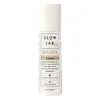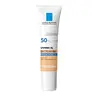Glow Lab Tinted SPF 15 Facial Moisturiser Versus La Roche-Posay Uvidea Anthelios Tinted BB Cream SPF 50+
What's inside
What's inside
 Key Ingredients
Key Ingredients

 Benefits
Benefits

 Concerns
Concerns

 Ingredients Side-by-side
Ingredients Side-by-side

Octocrylene 8%
UV AbsorberButyl Methoxydibenzoylmethane 1.3%
UV AbsorberTitanium Dioxide 4.2%
Cosmetic ColorantWater
Skin ConditioningGlycerin
HumectantHelianthus Annuus Flower
Skin ConditioningCocos Nucifera Oil
MaskingCetyl Alcohol
EmollientCaprylic/Capric Triglyceride
MaskingDicaprylyl Ether
EmollientGlyceryl Stearate
EmollientCeteareth-20
CleansingPolyglyceryl-3 Stearate
EmulsifyingSucrose Stearate
EmollientTocopheryl Acetate
AntioxidantHydroxyethylcellulose
Emulsion StabilisingXanthan Gum
EmulsifyingCI 77492
Cosmetic ColorantMica
Cosmetic ColorantPhenoxyethanol
PreservativeEthylhexylglycerin
Skin ConditioningPelargonium Graveolens Flower Oil
MaskingCitronellol
PerfumingGeraniol
PerfumingLimonene
PerfumingOctocrylene 8%, Butyl Methoxydibenzoylmethane 1.3%, Titanium Dioxide 4.2%, Water, Glycerin, Helianthus Annuus Flower, Cocos Nucifera Oil, Cetyl Alcohol, Caprylic/Capric Triglyceride, Dicaprylyl Ether, Glyceryl Stearate, Ceteareth-20, Polyglyceryl-3 Stearate, Sucrose Stearate, Tocopheryl Acetate, Hydroxyethylcellulose, Xanthan Gum, CI 77492, Mica, Phenoxyethanol, Ethylhexylglycerin, Pelargonium Graveolens Flower Oil, Citronellol, Geraniol, Limonene
Water
Skin ConditioningCI 77891
Cosmetic ColorantEthylhexyl Methoxycinnamate
UV AbsorberGlycerin
HumectantDrometrizole Trisiloxane
UV AbsorberDimethicone
EmollientAlcohol Denat.
AntimicrobialTitanium Dioxide
Cosmetic ColorantTerephthalylidene Dicamphor Sulfonic Acid
UV AbsorberPropylene Glycol
HumectantDiethylamino Hydroxybenzoyl Hexyl Benzoate
UV FilterTriethanolamine
BufferingCI 77491
Cosmetic ColorantCI 77492
Cosmetic ColorantCI 77499
Cosmetic ColorantBis-Ethylhexyloxyphenol Methoxyphenyl Triazine
Skin ConditioningStearic Acid
CleansingPotassium Cetyl Phosphate
EmulsifyingPentylene Glycol
Skin ConditioningAluminum Hydroxide
EmollientBHT
AntioxidantButylene Glycol
HumectantButyrospermum Parkii Seedcake Extract
Skin ProtectingCaprylyl Glycol
EmollientCarbomer
Emulsion StabilisingCarnosine
Skin ConditioningCetyl Alcohol
EmollientDisodium EDTA
Glyceryl Stearate
EmollientMyristic Acid
CleansingMyristyl Alcohol
EmollientPalmitic Acid
EmollientPEG-100 Stearate
Phenoxyethanol
PreservativeSodium Chloride
MaskingSodium Cocoyl Sarcosinate
CleansingStearyl Alcohol
EmollientTocopherol
AntioxidantTromethamine
BufferingXanthan Gum
EmulsifyingWater, CI 77891, Ethylhexyl Methoxycinnamate, Glycerin, Drometrizole Trisiloxane, Dimethicone, Alcohol Denat., Titanium Dioxide, Terephthalylidene Dicamphor Sulfonic Acid, Propylene Glycol, Diethylamino Hydroxybenzoyl Hexyl Benzoate, Triethanolamine, CI 77491, CI 77492, CI 77499, Bis-Ethylhexyloxyphenol Methoxyphenyl Triazine, Stearic Acid, Potassium Cetyl Phosphate, Pentylene Glycol, Aluminum Hydroxide, BHT, Butylene Glycol, Butyrospermum Parkii Seedcake Extract, Caprylyl Glycol, Carbomer, Carnosine, Cetyl Alcohol, Disodium EDTA, Glyceryl Stearate, Myristic Acid, Myristyl Alcohol, Palmitic Acid, PEG-100 Stearate, Phenoxyethanol, Sodium Chloride, Sodium Cocoyl Sarcosinate, Stearyl Alcohol, Tocopherol, Tromethamine, Xanthan Gum
Ingredients Explained
These ingredients are found in both products.
Ingredients higher up in an ingredient list are typically present in a larger amount.
Cetyl Alcohol is a fatty alcohol. Fatty Alcohols are most often used as an emollient or to thicken a product.
Its main roles are:
Though it has "alcohol" in the name, it is not related to denatured alcohol or ethyl alcohol.
The FDA allows products labeled "alcohol-free" to have fatty alcohols.
Learn more about Cetyl AlcoholCi 77492 is also hydrated iron III oxide. It's sole purpose is to give a yellow hue to products.
Iron III oxides are classified as inorganic chemicals for coloring.
Synthetically created Ci 77492 is considered safer than those naturally found. This is because the synthetically created version may contain less impurities. Iron oxides are generally non-toxic and non-allergenic.
Learn more about CI 77492Glycerin is already naturally found in your skin. It helps moisturize and protect your skin.
A study from 2016 found glycerin to be more effective as a humectant than AHAs and hyaluronic acid.
As a humectant, it helps the skin stay hydrated by pulling moisture to your skin. The low molecular weight of glycerin allows it to pull moisture into the deeper layers of your skin.
Hydrated skin improves your skin barrier; Your skin barrier helps protect against irritants and bacteria.
Glycerin has also been found to have antimicrobial and antiviral properties. Due to these properties, glycerin is often used in wound and burn treatments.
In cosmetics, glycerin is usually derived from plants such as soybean or palm. However, it can also be sourced from animals, such as tallow or animal fat.
This ingredient is organic, colorless, odorless, and non-toxic.
Glycerin is the name for this ingredient in American English. British English uses Glycerol/Glycerine.
Learn more about GlycerinGlyceryl Stearate is a mix of glycerin and stearic acid.
It is used to stabilize the mixing of water and oil ingredients. By preventing these ingredients from separating, it can help elongate shelf life. It can also help thicken the product's texture.
As an emollient, it helps soften skin and supports barrier-replenishing ingredients.
In cosmetics, Glyceryl Stearate is often made from vegetable oils or synthetically produced.
This ingredient may not be fungal-acne safe
Fun fact: The human body also creates Glyceryl Stearate naturally.
Learn more about Glyceryl StearatePhenoxyethanol is a preservative that has germicide, antimicrobial, and aromatic properties. Studies show that phenoxyethanol can prevent microbial growth. By itself, it has a scent that is similar to that of a rose.
It's often used in formulations along with Caprylyl Glycol to preserve the shelf life of products.
Titanium dioxide is a mineral UV filter widely used in sunscreens and cosmetics.
It is one of only two UV filters officially classified as “mineral” by regulatory agencies, the other being zinc oxide.
Titanium dioxide provides broad-spectrum protection mostly in the UVB and UVAII range, with some protection in the UVAI range.
While its UVA protection isn’t as strong as zinc oxide’s, the difference is minor.
A common myth is that mineral UV filters reflect UV light. However, modern research shows titanium dioxide absorbs UV radiation like chemical filters (~95% absorption & 5% reflection).
Thanks to its non-irritating nature, titanium dioxide is suitable for sensitive, acne-prone, or redness-prone skin. It is unlikely to cause "eye sting" like other sunscreen ingredients.
A major drawback of this ingredient is its white cast and thick texture. This is why mineral sunscreens often leave a white cast and are less cosmetically elegant than chemical/hybrid sunscreens.
To improve white cast and spreadability, micronized or nano-sized titanium dioxide is often used.
There are ongoing concerns surrounding nano-titanium oxide's impact on marine ecosystems.
There is no conclusive evidence that any form of titanium oxide (or any other sunscreen ingredients) will cause harm to marine ecosystems or coral reefs. The science is still developing but many consumers are keeping a close eye on this issue.
Please note, many destinations have reef-safety sunscreen rules. For instance, the U.S. Virgin Islands advises all visitors to use non-nano mineral sunscreens.
Nano mineral sunscreens once raised safety concerns about absorption into skin.
Extensive research has shown that they do not penetrate healthy or damaged skin; they remain safely on the surface and the top layer of dead skin (stratum corneum).
You'll likely find titanium dioxide bundled with alumina, silica, or dimethicone. These ingredients help make titanium dioxide highly photostable; this prevents it from interacting with other formula components under UV light.
Learn more about Titanium DioxideWater. It's the most common cosmetic ingredient of all. You'll usually see it at the top of ingredient lists, meaning that it makes up the largest part of the product.
So why is it so popular? Water most often acts as a solvent - this means that it helps dissolve other ingredients into the formulation.
You'll also recognize water as that liquid we all need to stay alive. If you see this, drink a glass of water. Stay hydrated!
Learn more about WaterXanthan gum is used as a stabilizer and thickener within cosmetic products. It helps give products a sticky, thick feeling - preventing them from being too runny.
On the technical side of things, xanthan gum is a polysaccharide - a combination consisting of multiple sugar molecules bonded together.
Xanthan gum is a pretty common and great ingredient. It is a natural, non-toxic, non-irritating ingredient that is also commonly used in food products.
Learn more about Xanthan Gum